Tianchen Zhao
MiroThinker: Pushing the Performance Boundaries of Open-Source Research Agents via Model, Context, and Interactive Scaling
Nov 18, 2025Abstract:We present MiroThinker v1.0, an open-source research agent designed to advance tool-augmented reasoning and information-seeking capabilities. Unlike previous agents that only scale up model size or context length, MiroThinker explores interaction scaling at the model level, systematically training the model to handle deeper and more frequent agent-environment interactions as a third dimension of performance improvement. Unlike LLM test-time scaling, which operates in isolation and risks degradation with longer reasoning chains, interactive scaling leverages environment feedback and external information acquisition to correct errors and refine trajectories. Through reinforcement learning, the model achieves efficient interaction scaling: with a 256K context window, it can perform up to 600 tool calls per task, enabling sustained multi-turn reasoning and complex real-world research workflows. Across four representative benchmarks-GAIA, HLE, BrowseComp, and BrowseComp-ZH-the 72B variant achieves up to 81.9%, 37.7%, 47.1%, and 55.6% accuracy respectively, surpassing previous open-source agents and approaching commercial counterparts such as GPT-5-high. Our analysis reveals that MiroThinker benefits from interactive scaling consistently: research performance improves predictably as the model engages in deeper and more frequent agent-environment interactions, demonstrating that interaction depth exhibits scaling behaviors analogous to model size and context length. These findings establish interaction scaling as a third critical dimension for building next-generation open research agents, complementing model capacity and context windows.
AuthGuard: Generalizable Deepfake Detection via Language Guidance
Jun 04, 2025Abstract:Existing deepfake detection techniques struggle to keep-up with the ever-evolving novel, unseen forgeries methods. This limitation stems from their reliance on statistical artifacts learned during training, which are often tied to specific generation processes that may not be representative of samples from new, unseen deepfake generation methods encountered at test time. We propose that incorporating language guidance can improve deepfake detection generalization by integrating human-like commonsense reasoning -- such as recognizing logical inconsistencies and perceptual anomalies -- alongside statistical cues. To achieve this, we train an expert deepfake vision encoder by combining discriminative classification with image-text contrastive learning, where the text is generated by generalist MLLMs using few-shot prompting. This allows the encoder to extract both language-describable, commonsense deepfake artifacts and statistical forgery artifacts from pixel-level distributions. To further enhance robustness, we integrate data uncertainty learning into vision-language contrastive learning, mitigating noise in image-text supervision. Our expert vision encoder seamlessly interfaces with an LLM, further enabling more generalized and interpretable deepfake detection while also boosting accuracy. The resulting framework, AuthGuard, achieves state-of-the-art deepfake detection accuracy in both in-distribution and out-of-distribution settings, achieving AUC gains of 6.15% on the DFDC dataset and 16.68% on the DF40 dataset. Additionally, AuthGuard significantly enhances deepfake reasoning, improving performance by 24.69% on the DDVQA dataset.
PM-KVQ: Progressive Mixed-precision KV Cache Quantization for Long-CoT LLMs
May 24, 2025



Abstract:Recently, significant progress has been made in developing reasoning-capable Large Language Models (LLMs) through long Chain-of-Thought (CoT) techniques. However, this long-CoT reasoning process imposes substantial memory overhead due to the large Key-Value (KV) Cache memory overhead. Post-training KV Cache quantization has emerged as a promising compression technique and has been extensively studied in short-context scenarios. However, directly applying existing methods to long-CoT LLMs causes significant performance degradation due to the following two reasons: (1) Large cumulative error: Existing methods fail to adequately leverage available memory, and they directly quantize the KV Cache during each decoding step, leading to large cumulative quantization error. (2) Short-context calibration: Due to Rotary Positional Embedding (RoPE), the use of short-context data during calibration fails to account for the distribution of less frequent channels in the Key Cache, resulting in performance loss. We propose Progressive Mixed-Precision KV Cache Quantization (PM-KVQ) for long-CoT LLMs to address the above issues in two folds: (1) To reduce cumulative error, we design a progressive quantization strategy to gradually lower the bit-width of KV Cache in each block. Then, we propose block-wise memory allocation to assign a higher bit-width to more sensitive transformer blocks. (2) To increase the calibration length without additional overhead, we propose a new calibration strategy with positional interpolation that leverages short calibration data with positional interpolation to approximate the data distribution of long-context data. Extensive experiments on 7B-70B long-CoT LLMs show that PM-KVQ improves reasoning benchmark performance by up to 8% over SOTA baselines under the same memory budget. Our code is available at https://github.com/thu-nics/PM-KVQ.
Optimal Transport-Guided Source-Free Adaptation for Face Anti-Spoofing
Mar 29, 2025Abstract:Developing a face anti-spoofing model that meets the security requirements of clients worldwide is challenging due to the domain gap between training datasets and diverse end-user test data. Moreover, for security and privacy reasons, it is undesirable for clients to share a large amount of their face data with service providers. In this work, we introduce a novel method in which the face anti-spoofing model can be adapted by the client itself to a target domain at test time using only a small sample of data while keeping model parameters and training data inaccessible to the client. Specifically, we develop a prototype-based base model and an optimal transport-guided adaptor that enables adaptation in either a lightweight training or training-free fashion, without updating base model's parameters. Furthermore, we propose geodesic mixup, an optimal transport-based synthesis method that generates augmented training data along the geodesic path between source prototypes and target data distribution. This allows training a lightweight classifier to effectively adapt to target-specific characteristics while retaining essential knowledge learned from the source domain. In cross-domain and cross-attack settings, compared with recent methods, our method achieves average relative improvements of 19.17% in HTER and 8.58% in AUC, respectively.
LiteVAR: Compressing Visual Autoregressive Modelling with Efficient Attention and Quantization
Nov 26, 2024Abstract:Visual Autoregressive (VAR) has emerged as a promising approach in image generation, offering competitive potential and performance comparable to diffusion-based models. However, current AR-based visual generation models require substantial computational resources, limiting their applicability on resource-constrained devices. To address this issue, we conducted analysis and identified significant redundancy in three dimensions of the VAR model: (1) the attention map, (2) the attention outputs when using classifier free guidance, and (3) the data precision. Correspondingly, we proposed efficient attention mechanism and low-bit quantization method to enhance the efficiency of VAR models while maintaining performance. With negligible performance lost (less than 0.056 FID increase), we could achieve 85.2% reduction in attention computation, 50% reduction in overall memory and 1.5x latency reduction. To ensure deployment feasibility, we developed efficient training-free compression techniques and analyze the deployment feasibility and efficiency gain of each technique.
DiTFastAttn: Attention Compression for Diffusion Transformer Models
Jun 12, 2024

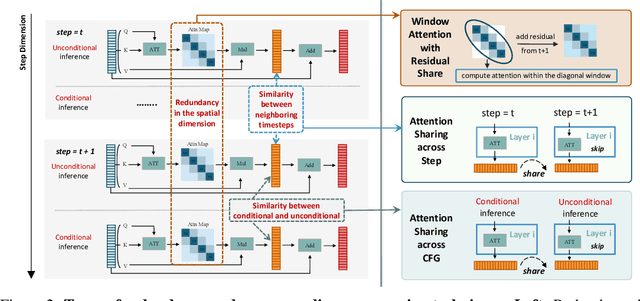
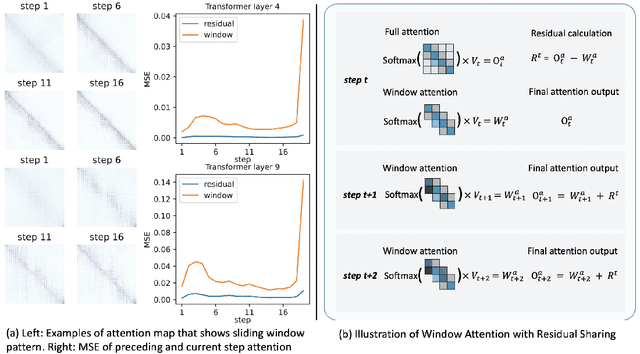
Abstract:Diffusion Transformers (DiT) excel at image and video generation but face computational challenges due to self-attention's quadratic complexity. We propose DiTFastAttn, a novel post-training compression method to alleviate DiT's computational bottleneck. We identify three key redundancies in the attention computation during DiT inference: 1. spatial redundancy, where many attention heads focus on local information; 2. temporal redundancy, with high similarity between neighboring steps' attention outputs; 3. conditional redundancy, where conditional and unconditional inferences exhibit significant similarity. To tackle these redundancies, we propose three techniques: 1. Window Attention with Residual Caching to reduce spatial redundancy; 2. Temporal Similarity Reduction to exploit the similarity between steps; 3. Conditional Redundancy Elimination to skip redundant computations during conditional generation. To demonstrate the effectiveness of DiTFastAttn, we apply it to DiT, PixArt-Sigma for image generation tasks, and OpenSora for video generation tasks. Evaluation results show that for image generation, our method reduces up to 88\% of the FLOPs and achieves up to 1.6x speedup at high resolution generation.
Principles of Designing Robust Remote Face Anti-Spoofing Systems
Jun 06, 2024

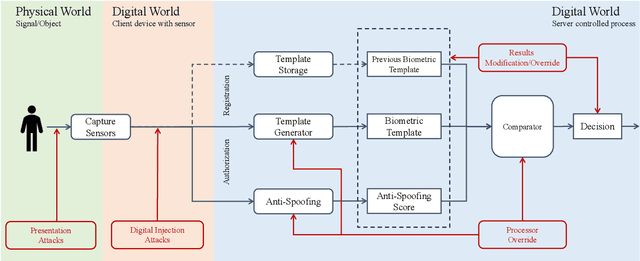

Abstract:Protecting digital identities of human face from various attack vectors is paramount, and face anti-spoofing plays a crucial role in this endeavor. Current approaches primarily focus on detecting spoofing attempts within individual frames to detect presentation attacks. However, the emergence of hyper-realistic generative models capable of real-time operation has heightened the risk of digitally generated attacks. In light of these evolving threats, this paper aims to address two key aspects. First, it sheds light on the vulnerabilities of state-of-the-art face anti-spoofing methods against digital attacks. Second, it presents a comprehensive taxonomy of common threats encountered in face anti-spoofing systems. Through a series of experiments, we demonstrate the limitations of current face anti-spoofing detection techniques and their failure to generalize to novel digital attack scenarios. Notably, the existing models struggle with digital injection attacks including adversarial noise, realistic deepfake attacks, and digital replay attacks. To aid in the design and implementation of robust face anti-spoofing systems resilient to these emerging vulnerabilities, the paper proposes key design principles from model accuracy and robustness to pipeline robustness and even platform robustness. Especially, we suggest to implement the proactive face anti-spoofing system using active sensors to significant reduce the risks for unseen attack vectors and improve the user experience.
ViDiT-Q: Efficient and Accurate Quantization of Diffusion Transformers for Image and Video Generation
Jun 04, 2024



Abstract:Diffusion transformers (DiTs) have exhibited remarkable performance in visual generation tasks, such as generating realistic images or videos based on textual instructions. However, larger model sizes and multi-frame processing for video generation lead to increased computational and memory costs, posing challenges for practical deployment on edge devices. Post-Training Quantization (PTQ) is an effective method for reducing memory costs and computational complexity. When quantizing diffusion transformers, we find that applying existing diffusion quantization methods designed for U-Net faces challenges in preserving quality. After analyzing the major challenges for quantizing diffusion transformers, we design an improved quantization scheme: "ViDiT-Q": Video and Image Diffusion Transformer Quantization) to address these issues. Furthermore, we identify highly sensitive layers and timesteps hinder quantization for lower bit-widths. To tackle this, we improve ViDiT-Q with a novel metric-decoupled mixed-precision quantization method (ViDiT-Q-MP). We validate the effectiveness of ViDiT-Q across a variety of text-to-image and video models. While baseline quantization methods fail at W8A8 and produce unreadable content at W4A8, ViDiT-Q achieves lossless W8A8 quantization. ViDiTQ-MP achieves W4A8 with negligible visual quality degradation, resulting in a 2.5x memory optimization and a 1.5x latency speedup.
MixDQ: Memory-Efficient Few-Step Text-to-Image Diffusion Models with Metric-Decoupled Mixed Precision Quantization
May 30, 2024



Abstract:Diffusion models have achieved significant visual generation quality. However, their significant computational and memory costs pose challenge for their application on resource-constrained mobile devices or even desktop GPUs. Recent few-step diffusion models reduces the inference time by reducing the denoising steps. However, their memory consumptions are still excessive. The Post Training Quantization (PTQ) replaces high bit-width FP representation with low-bit integer values (INT4/8) , which is an effective and efficient technique to reduce the memory cost. However, when applying to few-step diffusion models, existing quantization methods face challenges in preserving both the image quality and text alignment. To address this issue, we propose an mixed-precision quantization framework - MixDQ. Firstly, We design specialized BOS-aware quantization method for highly sensitive text embedding quantization. Then, we conduct metric-decoupled sensitivity analysis to measure the sensitivity of each layer. Finally, we develop an integer-programming-based method to conduct bit-width allocation. While existing quantization methods fall short at W8A8, MixDQ could achieve W8A8 without performance loss, and W4A8 with negligible visual degradation. Compared with FP16, we achieve 3-4x reduction in model size and memory cost, and 1.45x latency speedup.
FlashEval: Towards Fast and Accurate Evaluation of Text-to-image Diffusion Generative Models
Mar 25, 2024
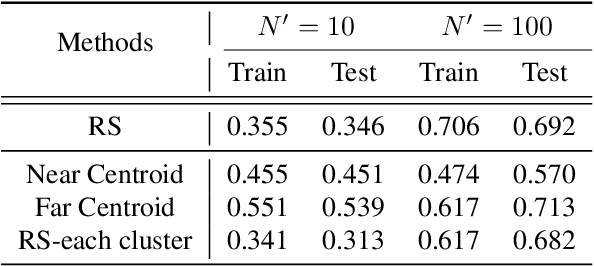
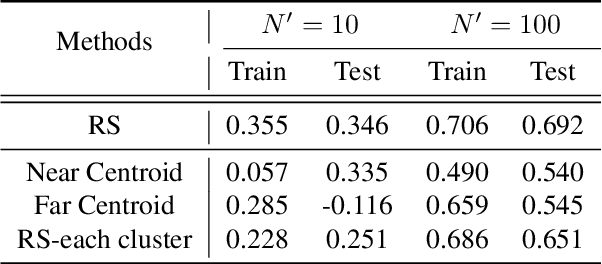
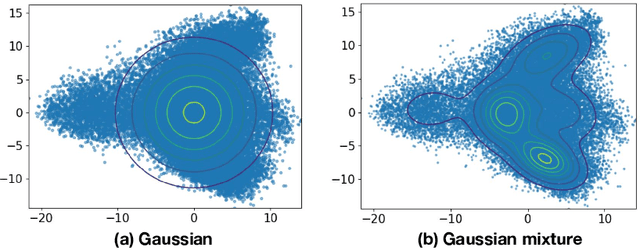
Abstract:In recent years, there has been significant progress in the development of text-to-image generative models. Evaluating the quality of the generative models is one essential step in the development process. Unfortunately, the evaluation process could consume a significant amount of computational resources, making the required periodic evaluation of model performance (e.g., monitoring training progress) impractical. Therefore, we seek to improve the evaluation efficiency by selecting the representative subset of the text-image dataset. We systematically investigate the design choices, including the selection criteria (textural features or image-based metrics) and the selection granularity (prompt-level or set-level). We find that the insights from prior work on subset selection for training data do not generalize to this problem, and we propose FlashEval, an iterative search algorithm tailored to evaluation data selection. We demonstrate the effectiveness of FlashEval on ranking diffusion models with various configurations, including architectures, quantization levels, and sampler schedules on COCO and DiffusionDB datasets. Our searched 50-item subset could achieve comparable evaluation quality to the randomly sampled 500-item subset for COCO annotations on unseen models, achieving a 10x evaluation speedup. We release the condensed subset of these commonly used datasets to help facilitate diffusion algorithm design and evaluation, and open-source FlashEval as a tool for condensing future datasets, accessible at https://github.com/thu-nics/FlashEval.
 Add to Chrome
Add to Chrome Add to Firefox
Add to Firefox Add to Edge
Add to Edge